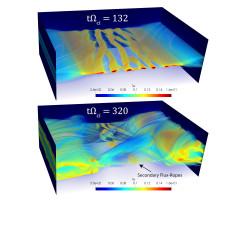Magnetic Reconnection: A bridge to Plasma Kinetic Scales

Hierarchical break-up of plasma current sheets to form magnetic flux-ropes. Initially at collisional macro-scales (top) and then evolving finer filaments at micro-scales (bottom).
Science Achievement
Researchers from Los Alamos National Laboratory (LANL) used Cori to show that magnetic reconnection in a collisional plasma current sheet generates electric forces that overcome the collisional friction, leading to the spontaneous formation of current sheets and magnetic flux-ropes at the kinetic micro-scales.
Impact
A key science question for solar flares – the largest explosions in the solar system - concerns how magnetic energy is released into plasma kinetic energy, and how energy is transferred from large magnetic field structures down to the micro-scales where it is dissipated. This study demonstrates that magnetic reconnection can act as a bridge to access these micro-scales. The kinetic current layers that form are smaller than can be detected by present day spacecraft missions.
Research Details
- The simulation used the Vector Particle-In-Cell (VPIC) code that solves the plasma kinetic equations with a Fokker-Planck collision operator.
- It contained 6.5 billion cells and 1.8 trillion particles, taking 15 million NERSC hours on Cori.
- The Cori Burst Buffer was crucial for simulation checkpointing and I/O of 100’s of TB of simulation data.
Related Links
Stanier et al., Physics of Plasmas 26, 072121 (2019).
Multimedia view: https://doi.org/10.1063/1.5100737.1
About NERSC and Berkeley Lab
The National Energy Research Scientific Computing Center (NERSC) is a U.S. Department of Energy Office of Science User Facility that serves as the primary high performance computing center for scientific research sponsored by the Office of Science. Located at Lawrence Berkeley National Laboratory, NERSC serves almost 10,000 scientists at national laboratories and universities researching a wide range of problems in climate, fusion energy, materials science, physics, chemistry, computational biology, and other disciplines. Berkeley Lab is a DOE national laboratory located in Berkeley, California. It conducts unclassified scientific research and is managed by the University of California for the U.S. Department of Energy. »Learn more about computing sciences at Berkeley Lab.







